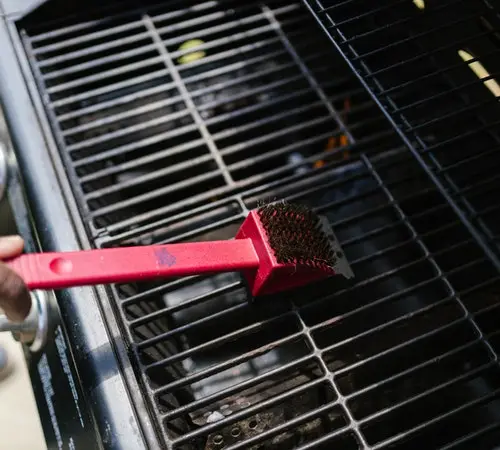This post may contain affiliate links. If you use these links to buy something we may earn a small commission. Thanks.
Summer is upon us, and most people plan to do backyard barbecuing and grilling. Each time you grill meat, burgers, and other types of food, they produce carbon deposits. These residues accumulate over the grill grates, burner tubes, flavoring bars, lid, and the inner side of the firebox. Carbon residues are crusty and unappealing. If you fail to deep-clean your gas grill, carbon deposits, baked-on food, and grease will continue to build up. Thus, you need to know how to clean a gas grill and try it on your equipment. We will teach you the whole process next.
Why you should deep clean your gas grill
We have just revealed how carbon residues can form on your grill. Avoid using your grill without deep cleaning it to eradicate these residues. If you ignore cleaning, grease and sweet food juices will stick to the crusty carbon deposits and allow the bacteria to grow. Moreover, the carbon-covered grill will spread heat unevenly as it will not attain the maximum operating temperature.
An unevenly heated grill may not cook the interiors of your meat well. If you do not have a reliable digital food thermometer, you could serve undercooked food. Moreover, carbon buildup can make your gas burner tubes susceptible to damage. Besides, the food and grease that stick to the carbon residues can increase the odds of a flare-up when cooking. You can stop carbon buildups by scrubbing your grills after each use.
How often should you deep-clean your gas grill?
Wiping down your gas grill should only happen after deep cleaning it. How often to deep-clean your grill depends on your cooking patterns. If you love to do backyard BBQs a few times a week, your grill needs thorough cleaning every sixty days. For instance, you should deep-clean your gas grill twice this summer.
If you occasionally grill food, cleaning your grill once per season is fine. Lastly, if you cook a lot of food at once daily, clean your equipment with a wire brush after every use. Last time we wrote about how to put your charcoal grill out. Today, we will teach you how to clean a gas grill and use the same techniques to wash your charcoal grill.
Items you need for the cleaning exercise
Gather grill cleaning tools before you begin the exercise. Some of these are easy to find at your local hardware shop. Others are available on Amazon and similar online stores. Some of these products are chemicals you might not want to use if you like to produce natural food flavors. Generally, all you require to give your gas grill a thorough wash include:
- A wire brush with a long handle
- One 5-gallon pail
- A wire bottle brush
- Warm water
- Dishwashing soap
- Cleaning vinegar
- Baking soda
- Stainless steel cleaner(optional)
- Rubber gloves(with long cuffs)
- Scouring sponges
- Absorbent rags
How to clean a gas grill – The technique
Gas grills come from different brands, including Weber, and some have stainless steel surfaces. If you have a stainless steel gas grill, an exclusive cleaner for this material is vital. No matter the gas grill you use, do the following steps to make it sparkle:

Step 1: Turn on your grill
- To fire up your gas grill, close the lid, turn the grill on, and wait for it to reach the maximum temperature.
- Leave the equipment alone for thirty minutes. Extreme heat will melt the sticky grease and baked-on food.
- Fill your 5-gallon pail with warm water, add some dish soap, and mix well with your hands. We are assuming you have already worn your gloves.
- Submerge your long-handled wire brush into the warm, soapy water and use it to scrub the grill grates. Scrubbing will remove the loosened carbon deposits.
- Switch off the gas and disconnect it from the propane tank. Allow it to cool down.
Step 2: Dismantle the grates and flavor bars and soak them
- Ensure that the gas grill is cool and safe to touch.
- Disconnect the grates and flavor bars. Soak them in warm, soapy water for about half an hour.
- Detach other components of your gas grill, including warming racks, burner tubes, grease trays, and burner-control knobs.
Step 3: Vacuum the firebox
- After the removal of grill components, you will access the firebox. So, place an empty pail under the firebox to gather the dirty water.
- Scrape off any sticky substance from the interiors of the firebox with a putty knife.
- Next, suck up any remaining debris with a vacuum cleaner. A wet/dry vacuum cleaner is the best choice here.
- Use your garden hose to flush out any leftover dirt from the inside of the firebox.
Step 4: Thoroughly scrub every grill component
- Remove the items you soaked in warm, soapy water and scrub them with a wire brush.
- Mix your cleaning vinegar (white vinegar) and baking soda to make a paste. Apply this paste to areas with baked-on debris that did not dissolve in the warm, soapy water.
- Use your garden hose to rinse your grates and flavor bars.
- Place the cast-iron grates under the sun to make sure they dry well to avoid corrosion. If you notice rusty areas on porcelain areas, clean and cover them with some oil.
- If burners have rust or clogged-up holes, clean them. Now clean burner tubes exteriors with a wire brush. As they could hide insects and debris inside from being out of use for months, use a wire bottle brush to clean their interiors.
Step 5: Clean the exteriors of your grill
- The pail you placed under the firebox is full of dirty water. Pour it and refill the bucket with clean water. Add some dishwashing soap.
- Scrub down the outer side of your gas grill using a sponge. Although you can use steel wool or a scouring pad, they can scratch a coated surface. A large scouring sponge is adequate.
- Use your cotton rags to dry the grill surfaces.
Step 6: Wide up the task
- If you notice some stubborn greasy spots, use vinegar without baking powder to clean them. Rinse with clean water.
- If you still have stubborn grease, get high-quality grease-removal soap, clean, and rinse thoroughly.
- If you are satisfied with the results, assemble your grill components again. Ensure that you place each grill part in its original position, especially the burner tubes.
- Coat your cast-iron grates with some vegetable oil. Attach the propane tank again, close the lid, and fire up the grill to season the grates. Leave it alone for fifteen minutes and then turn it off.
- If you messed somewhere when reassembling the grill components, you will notice when you turn it on. Reassemble the grill parts and ensure you do it right this time.
- Prepare to cook the most delicious ham, pork, beef, and burgers on your spotless gas grill this summer.
How to clean a gas grill you have stored for years
When some people get a better gas or charcoal grill, they keep their previous one for several months. If you have ignored your gas grill this long and want to use it, clean it before use. All the same, you need to accept that some sticky gunk might never come out. To start, carry out the following steps:
- Mix your baking powder and water in a ratio of 3:3 to make a gooey paste.
- Use this paste to cover different components of your gas grill. Cover each part at a time to ensure you clean the whole thing.
- After that, spray the coated components with some vinegar as it is a stronger cleaning agent.
- Leave the gas grill for thirty minutes to allow the paste to dissolve the sticky slime.
- Use an old absorbent rag to wipe your grill grates.
- If your grill is so dirty due to neglect, the cleaning task can take longer. To clean your gas grill with minimal effort, prepare enough paste to do one thorough job. Otherwise, focus on one component at a time. Repeat steps two to five with each component until you complete the entire equipment.
FAQ
Do I need a grease-cutting cleaner when cleaning my gas grill?
Yes, as you learn how to clean a gas grill with minimal effort, use grease-cutting dish soap. If you have used your grill for years, you require a powerful grease-cutting soap. Having a small budget should not limit you from deep-cleaning your equipment. You can use grease removers you already have in the house.
These include vinegar, water, baking soda, dish soap, and ammonia. Mostly you will combine these items with water. For instance, you can mix baking soda and water, vinegar and water, or dish soap and water. Alternatively, you can use a mixture of dish soap and baking soda.
Should you clean a gas grill with chemicals?
We would not recommend washing your gas grill with chemicals. No matter how much you rinse the grill, some odors might remain. These can affect the natural flavors of the food you like to grill. Home-based ingredients we have recommended are the best choice.
What if I never clean my gas grill? What will happen to it?
An ignored gas grill will get murkier and dirtier with each use. More grease, baked-on food, and carbon deposits will build up. Before you know it, the grill surfaces will begin to change the flavor of your food. Moreover, the grill might develop an awful odor and look ugly.
As the mess accumulates, it will hinder even heat distribution and affect your grilling process. Eventually, the grill components will begin to fail one by one, and you will have junk. Do not wait until this happens because you now know how to clean a gas grill.
Conclusion
As you might have noted, cleaning your gas grill is easy. Once you understand the steps, you can also use them to clean a charcoal grill. Although you can buy cleaning materials online, never postpone the process because of a lack of money. Items like vinegar, baking soda, grease-cutting dish soap, and water are enough to give your gas grill a spotless look. As we have shown you how to clean a gas grill, try it this summer before you cook delicious meat and burgers.

